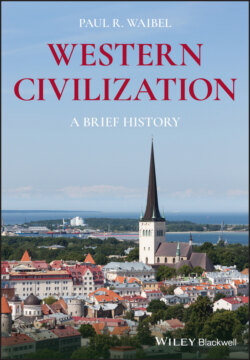Читать книгу Western Civilization - Paul R. Waibel - Страница 42
Roman Cultural Life
ОглавлениеWhile considering the period of the Pax Romana, it is fitting to pause and look briefly at the cultural achievements of the Romans. Their achievements in Latin literature may be divided chronologically into three periods, the Age of Cicero, the Augustan Age, and the Silver Age. The first was during the Republic and was dominated by Marcus Tullius Cicero (106–43 BC). Cicero was not only the greatest orator of his day, but also a poet, author, and philosopher. He left behind many speeches, political treatises, letters, and books, including his unfinished Republic, considered one of the earliest treatises on the concept of natural law.
Cicero's Latin prose is regarded as the finest ever written. It remained the standard for Latin through the Renaissance (mid‐fourteenth century to early seventeenth century), and some would say even to our own day. Second to Cicero was Julius Caesar. Though his speeches are lost, his Commentaries on the Gallic War is still read and studied by students of the classics. Two other names from the Age of Cicero worthy of note in this brief summary are Titus Lucretius Carsus (c. 99–c. 55 BC) and Gaius Valerius Catullus (84–54 BC).
Lucretius was an Epicurean philosopher and poet best remembered for his long didactic poem, On the Nature of the Universe. Its significance lies in the fact that it presents the atomic theory, along with the essence of Epicurean philosophy. Catullus, on the other hand, is remembered for his love poems about one Lesbia. In real life, Lesbia was a notorious woman named Clodia, with whom Catullus had an affair until she abandoned him for a friend of Cicero.
The period in Roman cultural life that parallels the reign of Augustus is referred to as the Augustan Age. Latin scholars are prone to call it the Golden Age. Augustus monopolized the patronage of all of the artists of the period with two goals in mind. He wanted to glorify his own reign, and he wanted to promote his campaign of restoring the virtues and morality of the old Roman Republic. Among the “greats” whom Augustus patronized, four names stand out as particularly noteworthy, Virgil (70–19 BC), Horace (65–8 BC), Livy (59 BC–AD 17), and Ovid (43 BC–AD 17).
Virgil's Aeneid is considered the greatest piece of Roman poetry by Rome's greatest poet. It relates the exploits of Aeneas, son of Anchises and hero of the Trojan War after the fall of Troy. In so doing, it tells the story of the founding of Rome. The Aeneid became a national epic, and, like Homer's Iliad and Odyssey, served as an inspiration and model for many subsequent epics in Western literature, including those of Dante and John Milton.
Horace was Virgil's successor. His Odes is a collection of lyric poems on love, pleasure, the brevity of life, and nature. Some of the poems eulogize Augustus, while others exalt the Greek philosophical notion of the “golden mean,” finding tranquility in life by avoiding extremes. He influenced later writers, among them William Wordsworth, Ben Jonson, W.H. Auden, Robert Frost, and many more.
Livy was a historian whose History recorded the history of Rome from its foundation to Livy's own day. Only 35 of its 142 books have survived. The main theme in Livy's portrayal of Rome's history is the moral decline and corruption of the Roman citizens following the end of the Punic Wars. The pursuit of personal peace and luxury replaced the old virtues of civic duty.
Ovid was a prolific poet and one of the leading figures in Roman society until his Art of Love, a sort of poetic handbook on how to seduce a lover, earned him the wrath of Augustus. His works were banished, and he was exiled to a remote corner of the Empire on the Black Sea.
The Augustan Age was followed by the Silver Age, referring to a group of writers who wrote during the period between the death of Augustus and c. 130. Their works are considered “great,” but not of the caliber of the Augustan Age. Noteworthy in this group are the stoic philosopher, Senecca (4 BC–AD 65); Petronius (27–66), author of Satykricon; the historian Tacitus (56–117), who recorded the period 14–96, and tells us much of what we know about the Germanic tribes in his Histories, Annals, and Germania; Juvenal (c. 55–127 AD) who satirized the immoral lifestyle of the Roman aristocracy in Satires; Suetonius (70–130), whose sensational Lives of the Caesars portrays in tabloid fashion, the decadent lives of the Caesars from Julius to Domitian; and finally Plutarch (45–120), who provides parallel biographical sketches of famous Greeks and Romans in Parallel Lives.
In other areas of cultural expression, the Romans tended to copy the Greeks. Roman sculptures are mostly copies of Greek originals. Portrait sculpture was one area in which the Romans broke with the past. They turned away from the idealized portraiture of the Greeks and portrayed the subject as he or she really was, with all the warts, scars, wrinkles, and other defects faithfully presented. Mosaics found wherever Romans settled was another area in which the Romans excelled. Few examples of Roman painting have survived, mostly in the ruins of Pompeii and Herculaneum, buried in 79 by the eruption of Mt. Vesuvius. Of Roman music, nothing remains. Those who have studied the references to it in Roman literature have concluded that we are not poorer for its loss.
